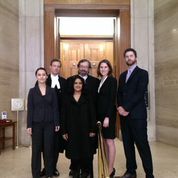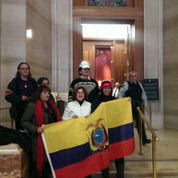Secondary menu
IHRP argues that Amazonian villagers deserve justice before Canada's Supreme Court
 12 December 2014 - Yesterday, the IHRP, along with its partners MiningWatch Canada and the Canadian Centre for International Justice (the “Joint Interveners”), made submissions before the Supreme Court of Canada in Yaiguaje v. Chevron Corporation. In addition to the Joint Interveners, the Court heard oral submissions with Chevron Corporation, Chevron Canada, and the Justice and Corporate Accountability Project. The Joint Interveners were represented by a team of University of Toronto alumni: Murray Klippenstein, Cory Wanless, and IHRP director Renu Mandhane.
12 December 2014 - Yesterday, the IHRP, along with its partners MiningWatch Canada and the Canadian Centre for International Justice (the “Joint Interveners”), made submissions before the Supreme Court of Canada in Yaiguaje v. Chevron Corporation. In addition to the Joint Interveners, the Court heard oral submissions with Chevron Corporation, Chevron Canada, and the Justice and Corporate Accountability Project. The Joint Interveners were represented by a team of University of Toronto alumni: Murray Klippenstein, Cory Wanless, and IHRP director Renu Mandhane.
The Lago Agrio litigation is a decades-long struggle between Chevron and Amazonian villagers who are seeking compensation for extensive pollution of the Amazon Rainforest between 1972 and 1990. In February 2011, after years of litigation in Ecuador, the Ecuadorian courts found Chevron Corporation liable in the amount of US$9.51 billion. Yaiguaje v Chevron Corporation is an attempt to enforce the $9.51 billion Ecuadorian judgment against Chevron Corporation and Chevron Canada (its wholly-owned subsidiary) in Ontario. Some of a Lago Agrio plaintiffs, along with their infamous US lawyer, Steven Donziger, were in attendance at the Supreme Court. One political activist was directed by Court staff to remove a t-shirt from the "Dirty Hand" campaign.
compensation for extensive pollution of the Amazon Rainforest between 1972 and 1990. In February 2011, after years of litigation in Ecuador, the Ecuadorian courts found Chevron Corporation liable in the amount of US$9.51 billion. Yaiguaje v Chevron Corporation is an attempt to enforce the $9.51 billion Ecuadorian judgment against Chevron Corporation and Chevron Canada (its wholly-owned subsidiary) in Ontario. Some of a Lago Agrio plaintiffs, along with their infamous US lawyer, Steven Donziger, were in attendance at the Supreme Court. One political activist was directed by Court staff to remove a t-shirt from the "Dirty Hand" campaign.
Before the Supreme Court, the Joint Interveners addressed: whether Ontario courts could exercise jurisdiction over Chevron Corporation and Chevron Canada, and whether the plaintiffs were entitled to payment of their judgment debt from the assets of Chevron Canada (through piercing of the corporate veil). Read the IHRP's factum in Yaiguaje v. Chevron Corporation.
In his submissions to the Court, Murray Klippenstein highlighted the importance of limiting jurisdictional hurdles in recognition and enforcement actions, which he argued is necessary to ensure access to justice for those whose rights have already been found to be violated by a foreign court.
He also argued that the Court must distinguish between corporate enterprises (comprised of a parent corporation and multiple wholly-owned subsidiaries) and corporations with individual or arms-length shareholders when analyzing whether or not Chevron Canada’s assets are available to satisfy the judgment. He argued that there is no principled basis for strictly maintaining seperate corporate personality for multinational corporate enterprises. Klippenstein referred extensively the work of then-UN Special Representative on Business and Human Rights, John Ruggie, while ably responding to questions by Justices Cromwell and Abella.
IHRP clinic students, Alison Mintoff (3L) and James Rendell (2L/MGA) were in attendance in the gallery, along with Sarah Beamish (3L/MGA), who summered at Klippensteins LLP. The students were thrilled to the see the Supreme Court in action, and struck by how many months of research and drafting goes into a 10 minute presentation before the Court. Both IHRP clinic students noted that being involved in the project was one of highlights of their experience at the University of Toronto Faculty of Law.
The Supreme Court has reserved judgement in the case.
The hearing received media coverage in Canada and the United States:
Chevron takes environmental legal battle before Supreme Court - Globe and Mail
How an environmental fight in Ecuador ended up in Canada's Supreme Court - Toronto Star
Epic Chevron oil pollution case goes before Canada's Supreme Court - BusinessWeek
